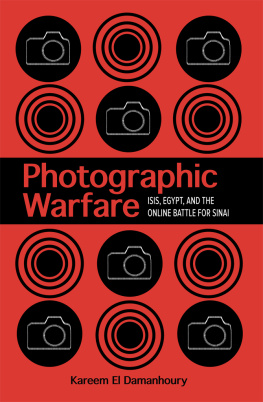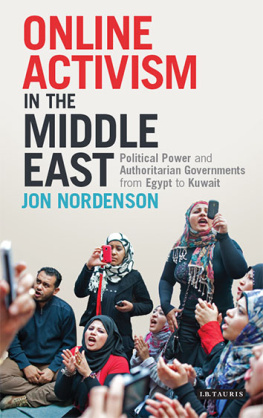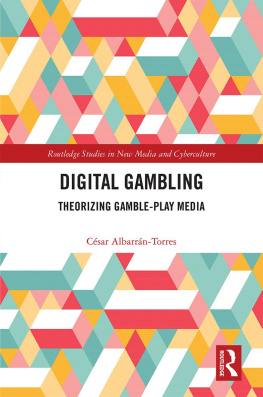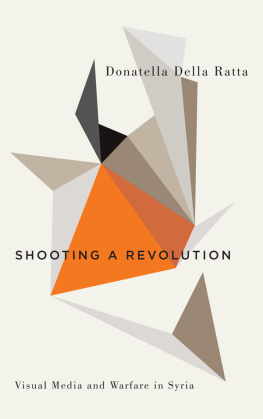Photographic Warfare

SERIES EDITORS
Sara Z. Kutchesfahani
Director, N Square D.C. Hub Research Associate, Center for International and Security Studies at Maryland
Amanda Murdie
Dean Rusk Scholar of International Relations and Professor of International Affairs, University of Georgia
SERIES ADVISORY BOARD
Kristin M. Bakke
Associate Professor of Political Science and International Relations, University College London
Fawaz Gerges
Professor of International Relations, London School of Economics and Political Science
Rafael M. Grossi
Ambassador of Argentina to Austria and International Organisations in Vienna
Bonnie D. Jenkins
University of Pennsylvania Perry World Center and The Brookings Institute Fellow
Jeffrey Knopf
Professor and Program Chair, Nonproliferation and Terrorism Studies, Middlebury Institute of International Studies at Monterey
Deepa Prakash
Assistant Professor of Political Science, DePauw University
Kenneth Paul Tan
Vice Dean of Academic Affairs and Associate Professor of Public Policy, The National University of Singapores (nus) Lee Kuan Yew School of Public Policy
Brian Winter
Editor-in-chief, Americas Quarterly
Photographic Warfare
ISIS, EGYPT, AND THE ONLINE BATTLE FOR SINAI
KAREEM EL DAMANHOURY
THE UNIVERSITY OF GEORGIA PRESS
Athens
2022 by the University of Georgia Press
Athens, Georgia 30602
www.ugapress.org
All rights reserved
Set in 10/12.5 Minion Pro by Kaelin Chappell Broaddus
Most University of Georgia Press titles are available from popular e-book vendors.
Printed digitally
Library of Congress Cataloging-in-Publication Data
Names: El Damanhoury, Kareem, author.
Title: Photographic warfare : ISIS, Egypt, and the online battle for Sinai / Kareem El Damanhoury.
Other titles: Studies in security and international affairs.
Description: Athens : The University of Georgia Press, [2022] | Series: Studies in security and international affairs | Includes bibliographical references and index.
Identifiers: LCCN 2022001410 | ISBN 9780820361628 (hardback) | ISBN 9780820361635 (paperback) | ISBN 9780820361611 (ebook)
Subjects: LCSH: IS (Organization) | TerrorismReligious aspectsIslam. | Islam and stateEgyptSinai. | Visual communicationPolitical aspectsEgyptSinai. | Terrorism and mass mediaMiddle East. | Psychological warfareEgyptSinai. | Sinai (Egypt)History.
Classification: LCC DT137.S55 E43 2022 | DDC 953/.1dc23/eng/20220401
LC record available at https://lccn.loc.gov/2022001410
To Egyptian soldiers whove sacrificed their lives for their country and to victims of terrorism everywhere
CONTENTS
MAP
FIGURES
PHOTOS
TABLES
I never would have been able to complete this book without the help, support, and generosity of my mentors and colleagues at the University of Tennessee, the University of Denver, Georgia State University, and beyond. Denvers College of Arts, Humanities, and Social Sciences provided needed resources for the book. The views presented here, nonetheless, are those of the author alone and do not represent those of the funding source. I would particularly like to thank GSU communications professor Carol Winkler who took the time to discuss, review, and provide indispensable insights toward the books development. For supporting the creation of this book, I also owe a debt of gratitude to professors Shawn Powers, Cynthia Hoffner, and Hyunjin Seo as well as DUs College of Arts, Humanities, and Social Sciences former dean, Daniel McIntosh; the colleges former associate dean, Ingrid Tague; DUs Media, Film, and Journalism Studies department chair, Lynn Schofield Clark; Yennhi Luu; Allison McManus; Mohannad Sabry; Omar Said; Lisa Bayer; Nathaniel Holly; and Elizabeth Adams.
I also want to acknowledge the patience and support I received from my life partner, children, and family in Egypt who too often listened passionately as I shared my ideas, put up with my absence, and motivated me to complete this project.
Photographic Warfare
Egypt is burning! My mother sobbed as she repeated this phrase over and over again to me while dozens of fellow conscripted soldiers stood in line behind me, waiting for their turn to use the phone. I had entered basic training two days before the first spark of the 2011 Egyptian revolution in Tahrir Square. Besides the daily three-minute call to my family, a portable battery radio was the only way I could get updates on the popular uprisings outside the walls of the military base. On January 28, 2011, now known as the Friday of Rage, I saw military tanks and armored vehicles heading out of the base, but headed where I was not sure. Later, I came to understand that the police had retreated the same day and the military had begun to deploy troops across the country. It was not long before many of my squad mates were dispatched to Sinai to secure the northern part of the peninsula. Although the Egyptian revolution to me remained a purely aural experience, others of my fellow soldiers soon became part of an intense, violent conflict in Sinai against a militant force that would later affiliate itself with ISIS, the so-called Islamic State of Iraq and al-Sham (the Levant).
Outside my military encampment on February 5, 2011, Sinai residents near the Egypt-Gaza border could see a huge blaze in North Sinais capital, al-Arish, about seventy kilometers away. An explosion had damaged a pipeline transporting gas to Israel. This sabotage, as the governor of North Sinai described it, disrupted the gas supply to Israel, which had occupied the Sinai Peninsula until 1982. The identity of the perpetrators, however, remained an open question, with some government officials suggesting a potential link to Palestinians entering Sinai through underground tunnels.
The gas pipeline from Sinai to Israel was part of a largely controversial deal that the two countries had struck several months after the conclusion of the Second Palestinian Intifada. In late June 2005, Egyptian oil minister Sameh Fahmi and Israeli minister for national infrastructure Benyamin Ben-Eliezer
When Mubarak stepped down on February 11, 2011, in response to the Arab Spring uprisings and the Supreme Council of the Armed Forces (SCAF) assumed control, the Egyptian-Israeli gas deal resurfaced as an issue of public concern in revolutionary Egypt. Essam Sharaf, then head of the Egyptian government, decided to revise the gas export contracts in April 2011. Shortly thereafter, the attorney general ordered the arrest of Sameh Fahmi and Hussein Salem for allegedly squandering $714 million in public funds for selling gas to Israel at an artificially low price.
In the same month, several individuals instigated the second gas pipeline explosion in North Sinai. Although the perpetrators remained unknown, their actions were very much in line with growing discontent over the gas deal. The former Court of Cassation vice president Mahmoud al-Khodeiri, who later headed the parliamentary legislative committee, even called on the unknown individuals to destroy the pipelines again if the Egyptian government did not halt the gas deal.













